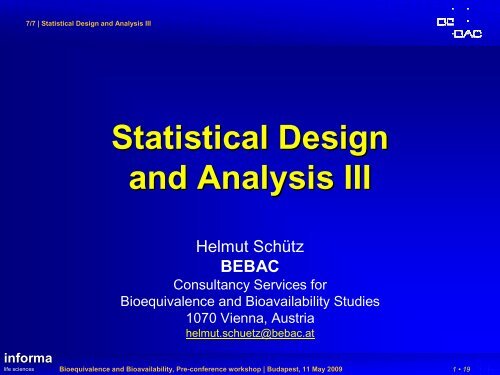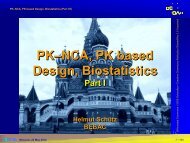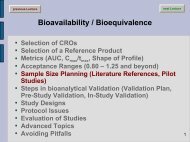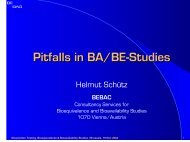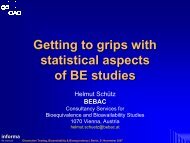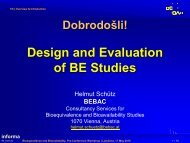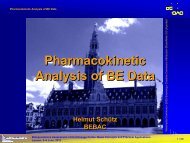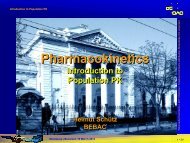Best Design of BE Studies (7) - BEBAC ⢠Consultancy Services for ...
Best Design of BE Studies (7) - BEBAC ⢠Consultancy Services for ...
Best Design of BE Studies (7) - BEBAC ⢠Consultancy Services for ...
Create successful ePaper yourself
Turn your PDF publications into a flip-book with our unique Google optimized e-Paper software.
7/7 | Statistical <strong>Design</strong> and Analysis IIII<br />
Statistical <strong>Design</strong><br />
and Analysis III<br />
Helmut Schütz<br />
<strong>BE</strong>BAC<br />
<strong>Consultancy</strong> <strong>Services</strong> <strong>for</strong><br />
Bioequivalence and Bioavailability <strong>Studies</strong><br />
1070 Vienna, Austria<br />
helmut.schuetz@bebac.at<br />
in<strong>for</strong>ma<br />
life sciences<br />
Bioequivalence and Bioavailability, Pre-conference workshop | Budapest, 11 May 2009 1 • 19
7/7 | Statistical <strong>Design</strong> and Analysis IIII<br />
Dose Proportionality<br />
in<strong>for</strong>ma<br />
life sciences<br />
Dose proportionality may be evaluated in a twostep<br />
procedure<br />
(Chow and Liu, <strong>Design</strong> and Analysis <strong>of</strong> Bioavailability and Bioequivalence<br />
<strong>Studies</strong>, Marcel Dekker, New York, pp 563–573 (3 rd ed 2009)<br />
Let Y be the response (AUC, C max ) and x the dose<br />
level. Since the standard deviation <strong>of</strong> Y increases<br />
with the dose, the primary assumption <strong>of</strong> dose proportionality<br />
is that the standard deviation <strong>of</strong> Y is proportional<br />
to x; that is,<br />
Var(Y) = x²σ²,<br />
where σ² consists <strong>of</strong> inter- and intrasubject<br />
variabilities.<br />
Bioequivalence and Bioavailability, Pre-conference workshop | Budapest, 11 May 2009 2 • 19
7/7 | Statistical <strong>Design</strong> and Analysis IIII<br />
Dose Proportionality<br />
Two-step procedure<br />
Under this assumption, following models are considered<br />
to evaluate the relation between response Y<br />
and dose x:<br />
Model 1:<br />
Model 2:<br />
Model 3:<br />
E(Y|x)=b·x<br />
E(Y|x)=a+b·x, where a≠0<br />
E(Y|x)=a·x b , where a>0 and b≠0<br />
in<strong>for</strong>ma<br />
life sciences<br />
Bioequivalence and Bioavailability, Pre-conference workshop | Budapest, 11 May 2009 3 • 19
7/7 | Statistical <strong>Design</strong> and Analysis IIII<br />
Dose Proportionality<br />
Two-step procedure<br />
Model 1 indicates that the relation between<br />
response and dose is linear.<br />
The dose response curve is a straight line, which<br />
passes through the origin.<br />
This model is commonly referred to as<br />
dose proportionality.<br />
in<strong>for</strong>ma<br />
life sciences<br />
Bioequivalence and Bioavailability, Pre-conference workshop | Budapest, 11 May 2009 4 • 19
7/7 | Statistical <strong>Design</strong> and Analysis IIII<br />
Dose Proportionality<br />
Two-step procedure<br />
Step 1 (dose proportionality)<br />
All dose dependent parameters (e.g., AUC, C max )<br />
are normalized to the dose <strong>of</strong> the reference prior<br />
to comparative analyses.<br />
Multiplicative model as usual in <strong>BE</strong>.<br />
Following hypotheses are evaluated during statistical<br />
analysis (given <strong>for</strong> bioavailability ratios):<br />
in<strong>for</strong>ma<br />
life sciences<br />
Bioequivalence and Bioavailability, Pre-conference workshop | Budapest, 11 May 2009 5 • 19
7/7 | Statistical <strong>Design</strong> and Analysis IIII<br />
Dose Proportionality<br />
in<strong>for</strong>ma<br />
life sciences<br />
Two-step procedure<br />
Step 1 (dose proportionality)<br />
H 1a0 : µ test 1 /µ ref. ≤θ 1 or µ test 1 /µ ref. ≥θ 2 : null hypothesis<br />
1a (µ test 1 and µ ref. are not dose proportional)<br />
H 1a1 : θ 1
7/7 | Statistical <strong>Design</strong> and Analysis IIII<br />
Dose Proportionality<br />
Two-step procedure<br />
Step 1 (dose proportionality)<br />
If the null hypothesis is rejected <strong>for</strong> a parameter,<br />
dose proportionality is proven within the<br />
compared dose levels.<br />
If, however, the null hypothesis is not rejected,<br />
in a second step dose linearity (Model 2), and<br />
departure from dose linearity (Model 3) has<br />
to be evaluated.<br />
in<strong>for</strong>ma<br />
life sciences<br />
Bioequivalence and Bioavailability, Pre-conference workshop | Budapest, 11 May 2009 7 • 19
7/7 | Statistical <strong>Design</strong> and Analysis IIII<br />
Dose Proportionality<br />
in<strong>for</strong>ma<br />
life sciences<br />
Two-step procedure<br />
Step 2 (dose linearity)<br />
Model 2 indicates that the relation between response<br />
and the dose follows a straight line with nonzero<br />
intercept (a). It will be tested using a weighted linear<br />
regression with weights equal to x -1 with the original<br />
(untrans<strong>for</strong>med) data (x,Y). The hypotheses <strong>of</strong><br />
primary interest are given as:<br />
H 20 : a=0 null hypothesis 2 (dose response curve<br />
passess through the origin)<br />
H 21 : a≠0 alternative hypothesis 2 (nonzero<br />
intercept)<br />
Bioequivalence and Bioavailability, Pre-conference workshop | Budapest, 11 May 2009 8 • 19
7/7 | Statistical <strong>Design</strong> and Analysis IIII<br />
Dose Proportionality<br />
Two-step procedure<br />
Step 2 (dose linearity)<br />
Model 3 indicates that the relation between response<br />
and the dose follows the <strong>for</strong>m <strong>of</strong> a power curve with<br />
the exponent b. It will be tested using a weighted<br />
nonlinear regression with weights equal to x -1 with<br />
the original (untrans<strong>for</strong>med) data (x,Y).<br />
Model 3 will be evaluated by examining the 95%<br />
confidence interval <strong>of</strong> the exponent b <strong>for</strong> departure<br />
from one.<br />
in<strong>for</strong>ma<br />
life sciences<br />
Bioequivalence and Bioavailability, Pre-conference workshop | Budapest, 11 May 2009 9 • 19
7/7 | Statistical <strong>Design</strong> and Analysis IIII<br />
Dose Proportionality<br />
Two-step procedure<br />
Step 2 (dose linearity)<br />
The hypotheses <strong>of</strong> primary interest are given as:<br />
H 30 : b=1 null hypothesis 3 (no departure from<br />
dose linearity)<br />
H 31 : b≠1 alternative hypothesis 3 (dose response<br />
curve follows a power curve)<br />
The departure from dose linearity will be evaluated<br />
by the 95% confidence interval (L,U) <strong>for</strong> b according<br />
to following decision criteria:<br />
in<strong>for</strong>ma<br />
life sciences<br />
Bioequivalence and Bioavailability, Pre-conference workshop | Budapest, 11 May 2009 10 • 19
7/7 | Statistical <strong>Design</strong> and Analysis IIII<br />
Dose Proportionality<br />
Two-step procedure<br />
Step 2 (dose linearity)<br />
if 0.75
7/7 | Statistical <strong>Design</strong> and Analysis IIII<br />
Dose Proportionality<br />
100<br />
80<br />
Model 1 (proportional)<br />
Model 2 (linear)<br />
Model 3 (nonlinear)<br />
Y (response)<br />
60<br />
40<br />
100<br />
in<strong>for</strong>ma<br />
life sciences<br />
20<br />
0<br />
0 10 20 30 40<br />
x (dose)<br />
Bioequivalence and Bioavailability, Pre-conference workshop | Budapest, 11 May 2009 12 • 19<br />
Y (response)<br />
10<br />
1<br />
Model 1 (proportional)<br />
Model 2 (linear)<br />
Model 3 (nonlinear)<br />
1 10 100<br />
x (dose)
7/7 | Statistical <strong>Design</strong> and Analysis IIII<br />
Dose Proportionality<br />
Two-step procedure<br />
Example (FIM biological, 6 dose levels, C max )<br />
response<br />
C max<br />
b<br />
0.587<br />
95 % CI (L,U)<br />
0.471<br />
0.704<br />
CV%<br />
7.28<br />
U b < 0.75<br />
Model 3 holds (deviation from dose linearity)<br />
Corr.<br />
0.9446<br />
in<strong>for</strong>ma<br />
life sciences<br />
Bioequivalence and Bioavailability, Pre-conference workshop | Budapest, 11 May 2009 13 • 19
7/7 | Statistical <strong>Design</strong> and Analysis IIII<br />
Dose Proportionality<br />
Two-step procedure<br />
Example (FIM, 6 dose levels, C max )<br />
2000<br />
1500<br />
Dose Proportionality (Cmax)<br />
1000<br />
500<br />
Observed<br />
Predicted<br />
0<br />
0 2 4 6 8 10 12<br />
dose (mg)<br />
in<strong>for</strong>ma<br />
life sciences<br />
Bioequivalence and Bioavailability, Pre-conference workshop | Budapest, 11 May 2009 14 • 19
7/7 | Statistical <strong>Design</strong> and Analysis IIII<br />
Thank You!<br />
Statistical <strong>Design</strong><br />
and Analysis III<br />
Open Questions?<br />
(WinNonlin User model in your handouts<br />
– use at your own risk!)<br />
Helmut Schütz<br />
<strong>BE</strong>BAC<br />
<strong>Consultancy</strong> <strong>Services</strong> <strong>for</strong><br />
Bioequivalence and Bioavailability <strong>Studies</strong><br />
1070 Vienna, Austria<br />
helmut.schuetz@bebac.at<br />
in<strong>for</strong>ma<br />
life sciences<br />
Bioequivalence and Bioavailability, Pre-conference workshop | Budapest, 11 May 2009 15 • 19
7/7 | Statistical <strong>Design</strong> and Analysis IIII<br />
Dose Proportionality<br />
in<strong>for</strong>ma<br />
life sciences<br />
WinNonlin user model<br />
remark DOSE PROPORTIONALITY, Chow/Liu 2009 p 564 Models 1-4<br />
remark data in original (untrans<strong>for</strong>med) scale (X/Y)<br />
remark weight = 1/x, weights must be provided in column 3<br />
remark (c) Helmut Schuetz, <strong>BE</strong>BAC, 1070 Vienna, Austria<br />
model 1<br />
remark Dose Proportionality<br />
remark Model 1: E(Y)=bx (linear through origin)<br />
remark b1 = slope<br />
remark weight = 1/x<br />
commands<br />
dnames 'dose' 'response'<br />
npar 1<br />
pname 'b1'<br />
initial 1<br />
nobounds<br />
method 3<br />
weight<br />
end<br />
func 1<br />
f = b1 * x<br />
end<br />
eom<br />
Bioequivalence and Bioavailability, Pre-conference workshop | Budapest, 11 May 2009 16 • 19
7/7 | Statistical <strong>Design</strong> and Analysis IIII<br />
Dose Proportionality<br />
WinNonlin user model<br />
model 2<br />
remark Dose Proportionality (Dose Linearity)<br />
remark Model 2: E(Y)=a+bx (linear)<br />
remark where a#0<br />
remark a = intercept<br />
remark b = slope<br />
remark weight = 1/x<br />
commands<br />
dnames 'dose' 'response'<br />
npar 2<br />
pname 'a2' 'b2'<br />
initial 0 1<br />
nobounds<br />
method 3<br />
weight<br />
end<br />
func 1<br />
f = a2 + b2 * x<br />
end<br />
eom<br />
in<strong>for</strong>ma<br />
life sciences<br />
Bioequivalence and Bioavailability, Pre-conference workshop | Budapest, 11 May 2009 17 • 19
7/7 | Statistical <strong>Design</strong> and Analysis IIII<br />
Dose Proportionality<br />
WinNonlin user model<br />
model 3<br />
remark Dose Proportionality (Nonlinear PK)<br />
remark Model 3: E(Y)=a*x^b (power function)<br />
remark where a>0 and b#0<br />
remark a = coefficient<br />
remark b = exponent ('curvature')<br />
remark weight = 1/x<br />
commands<br />
dnames 'dose' 'response'<br />
npar 2<br />
pname 'a3' 'b3'<br />
initial 1 1<br />
nobounds<br />
weight<br />
end<br />
func 1<br />
f = a3 * x ** b3<br />
end<br />
eom<br />
in<strong>for</strong>ma<br />
life sciences<br />
Bioequivalence and Bioavailability, Pre-conference workshop | Budapest, 11 May 2009 18 • 19
7/7 | Statistical <strong>Design</strong> and Analysis IIII<br />
Dose Proportionality<br />
WinNonlin user model<br />
model 4<br />
remark Dose Proportionality (Nonlinear PK)<br />
remark Model 4: E(Y)=a+c*x^b (power function with intercept)<br />
remark where a#0 and/or b#1<br />
remark a = intercept<br />
remark b = exponent ('curvature')<br />
remark c = coefficient<br />
remark weight = 1/x<br />
commands<br />
dnames 'dose' 'response'<br />
npar 3<br />
pname 'a4' 'b4' 'c4'<br />
initial 0 1 1<br />
nobounds<br />
weight<br />
end<br />
func 1<br />
f = a4 + c4 * x ** b4<br />
end<br />
eom<br />
in<strong>for</strong>ma<br />
life sciences<br />
Bioequivalence and Bioavailability, Pre-conference workshop | Budapest, 11 May 2009 19 • 19


